Blog
January 30th, 2010
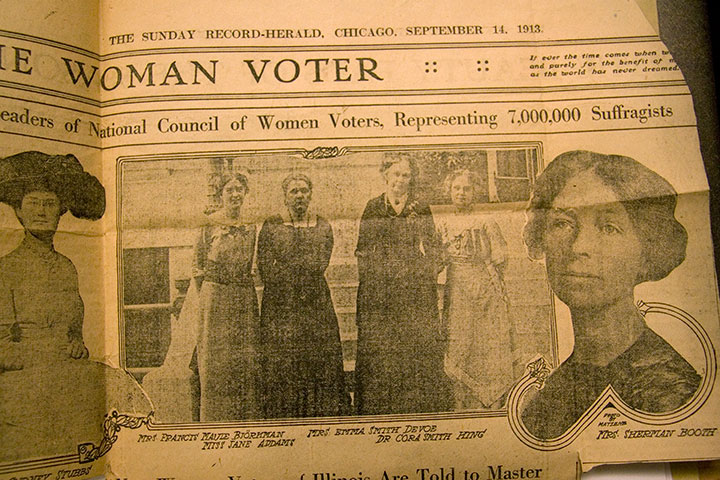
It’s just about that time again: Jessica and I are working hard on the next Dead Feminist broadside. She’s poring through texts and historical facts, and I’m pencilling as fast as my tendonitis will let me. This time we’ll be unveiling the new piece at the Washington State Library near Olympia; the staff invited us to give a lecture about the series next month.
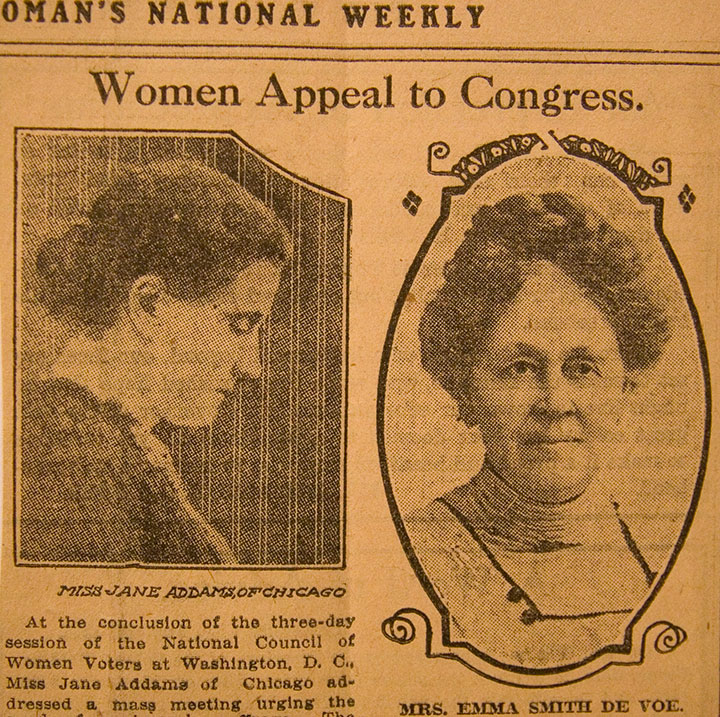
The library boasts the entire collection of letters and personal papers of Emma Smith DeVoe (pictured above, right), women’s rights activist and leader of the Washington suffragist movement. And since this year marks the 100th anniversary of women’s suffrage in Washington, we figured Emma would be a perfect fit for the new piece.
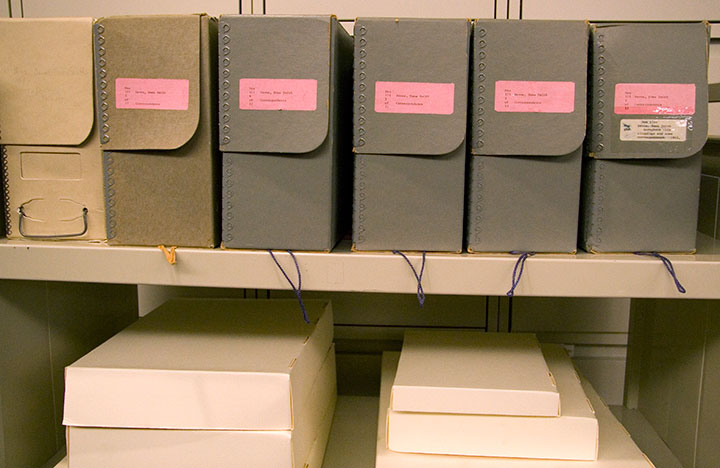
So a couple of weeks ago, Jessica, Zooey (R.I.P., J.D. Salinger) and I took a field trip to visit the archives and conduct a little research. When we arrived, we realized what they meant by “collection:” twelve enormous boxes packed full of letters, clippings and souvenirs. A “little” research obviously wasn’t going to happen.
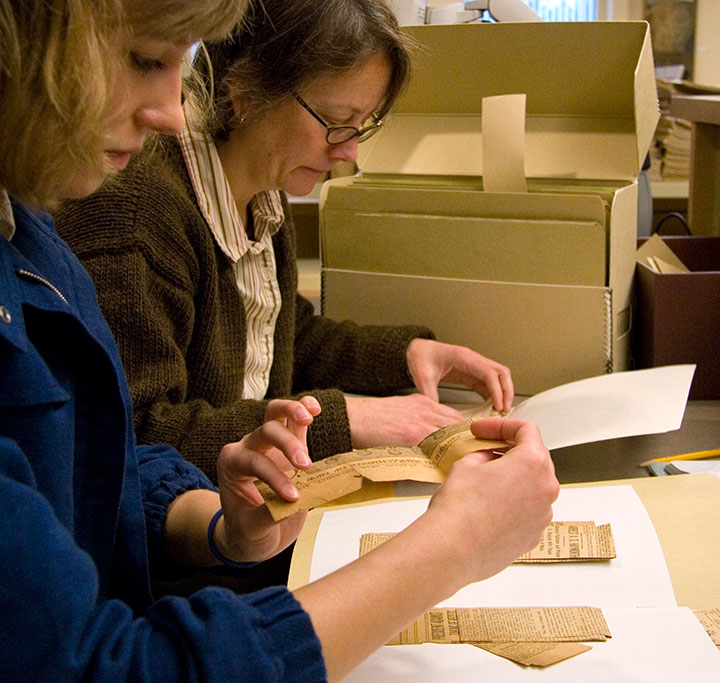
Luckily, the incredibly knowledgeable and helpful library staff (thank you, Sean!) let us take as much time and as many photos as we needed. So we cozied up to a work station and dived in, one box at a time. Together we went through literally thousands of pieces of paper.
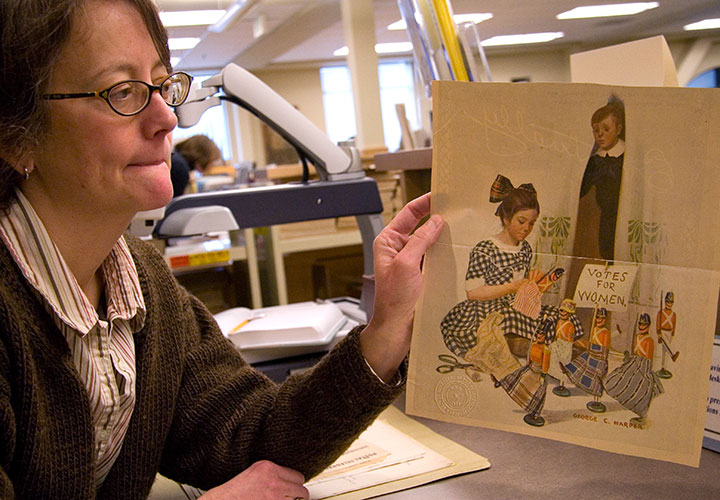
What we found was a fascinating collection of souvenirs, business cards, newspaper clippings,

leaflets and other propaganda,
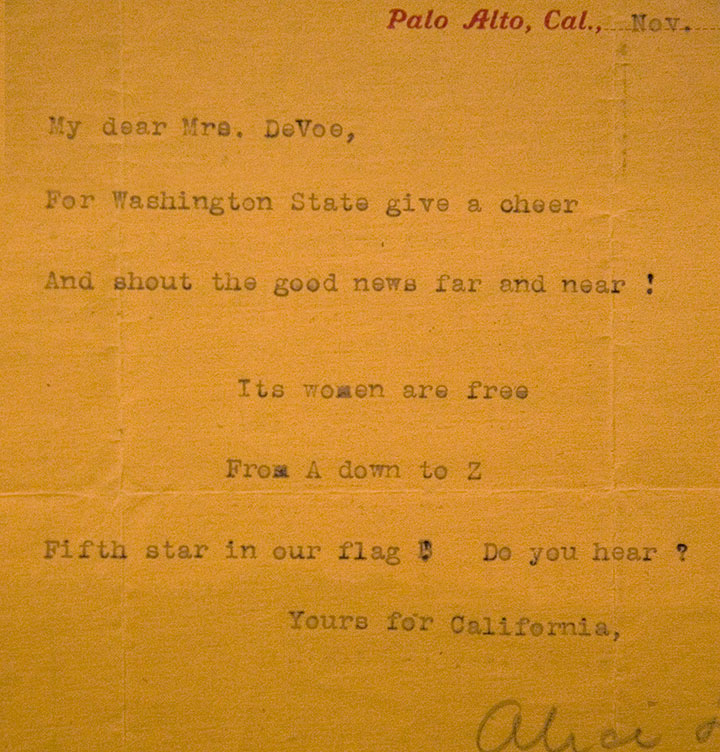
fan letters (Emma had an impressive array of admirers),
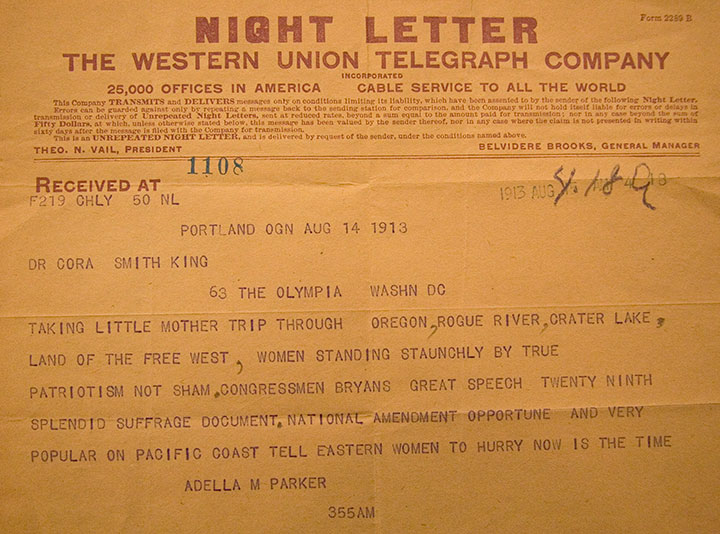
telegrams, notes from sitting U.S. senators and presidential aides, and reams and reams of correspondance between the members of the Washington suffragist movement.
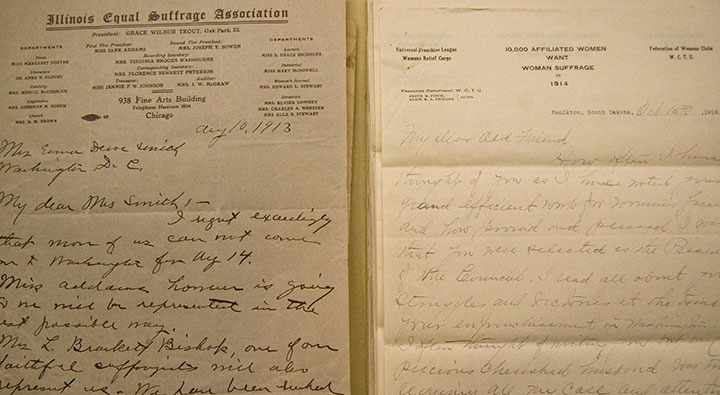
The trouble was, most of these documents were utterly mundane—letter after letter simply acknowledged receipt of previous correspondance, or gave detailed instructions for planning events and delegating tasks. Worst of all, Emma rarely made carbon copies of her half of the correspondance, so there was very little in her own voice.
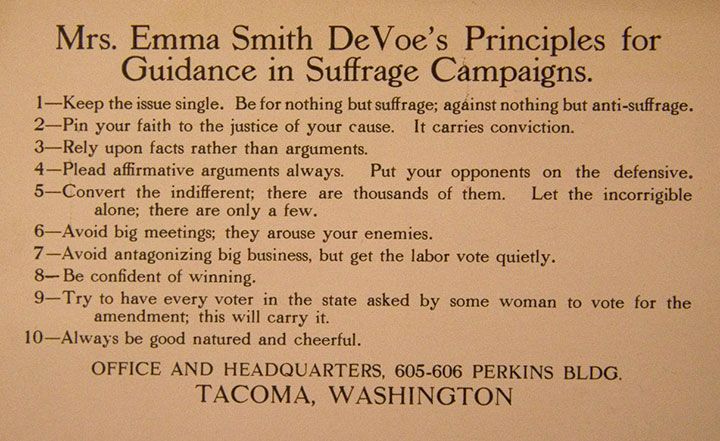
We spent nearly four hours poring over every folder and box, and the only potential Emma quotes we found were mined from this instructional card. Still, it didn’t feel like we had found our inspiration—just a few weeks from our talk, we had no quote and no social topic for the piece.
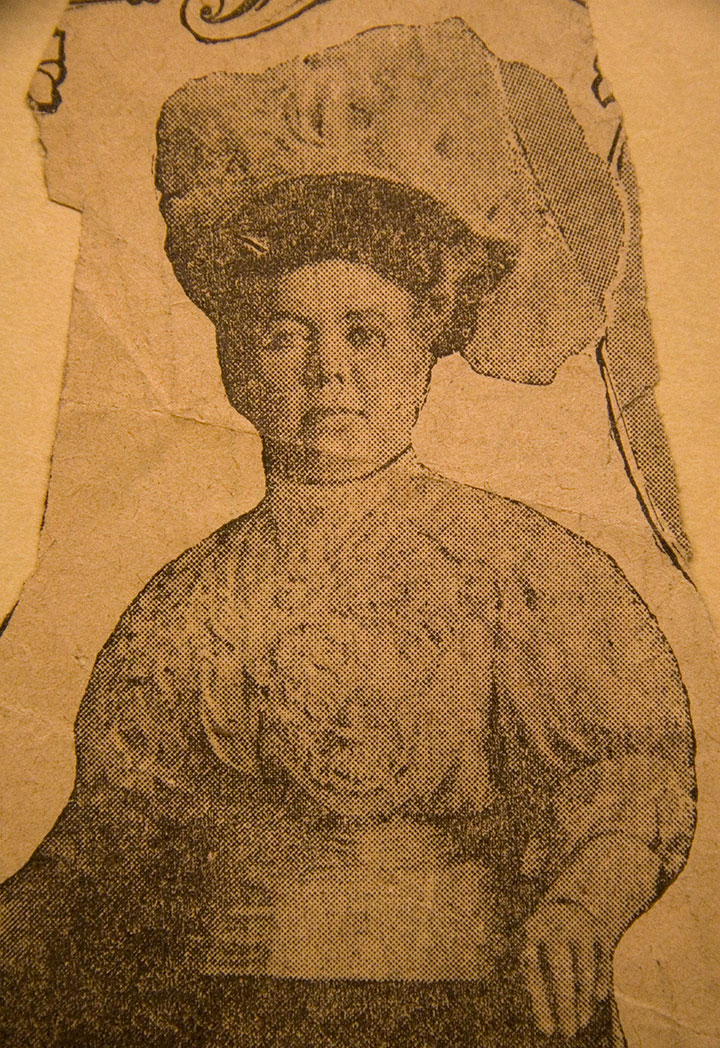
What we did have, however, was a much clearer picture of the women behind the fight for suffrage in our state (that’s May Arkwright Hutton above; she and Emma didn’t exactly get along), right down to addresses of homes and buildings still standing in Tacoma (the headquarters of the movement).
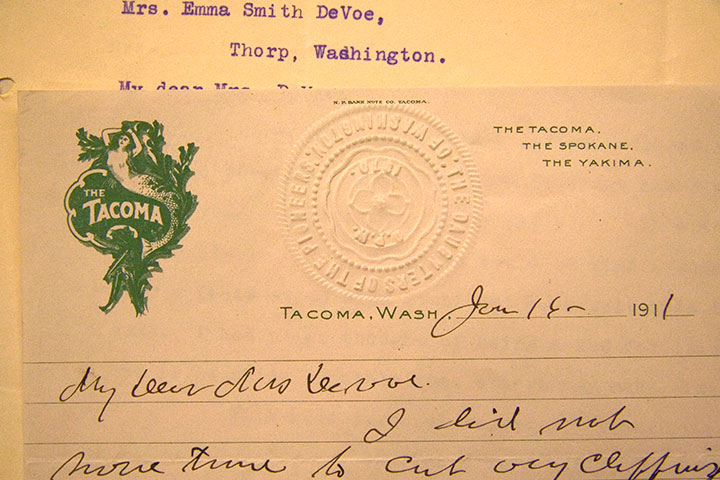
From the documents themselves to the individual script hands of each letter writer, we had an incredible window into political life from a hundred years ago.
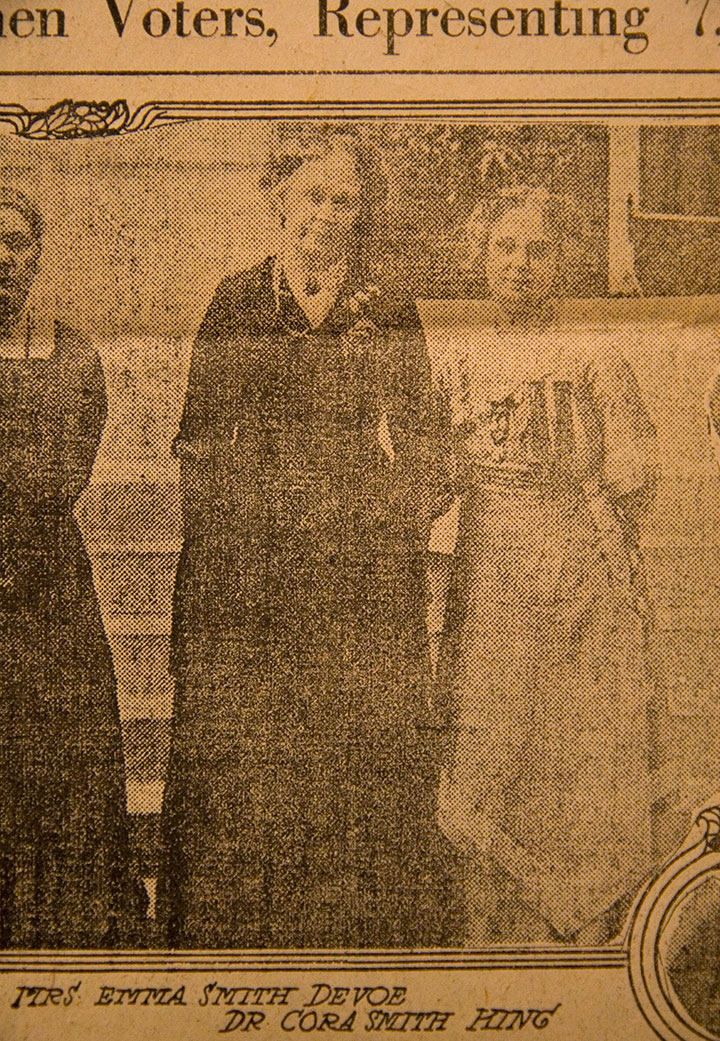
And we found a good lead. Just as interesting as Emma (and more forthcoming with their own voices) were Cora Smith Eaton King, M.D. (pictured above, right)—correspondent, fellow leader of the movement, and one of the first women to scale Mt. Rainier!—and Bernice Sapp—friend, activist, and the one who compiled this collection of documents and donated it to the library.
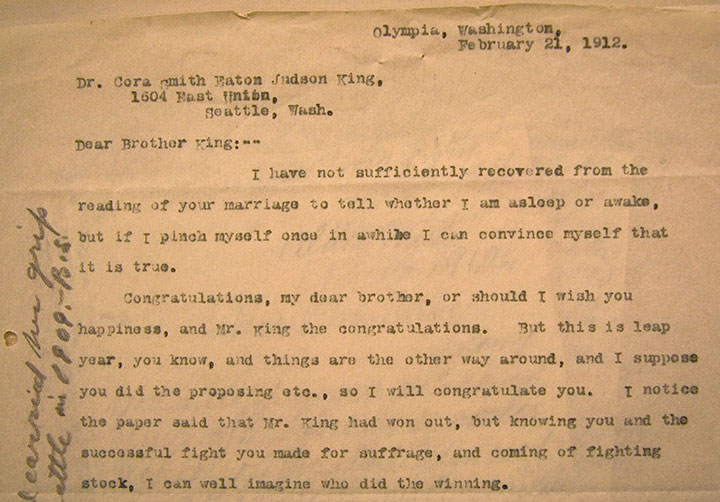
Bernice’s letters were full of quirky character and wit. We loved how she called Emma “the General,” and referred to herself and other suffragists by male titles: “Brother King,” “Mr. Hutton,” or simply “him.”
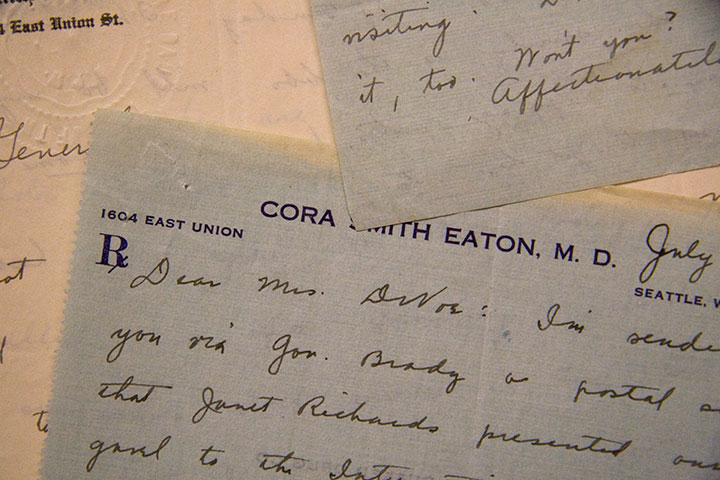
Cora, on the other hand, was a real firecracker. Her letters (often scribbled on scraps of paper, even her own prescription pad!) revealed an eloquent intelligence and a sizzling sense of humor. We fell head-over-heels for Cora, and began to doubt that Emma was the right voice for the broadside—still, though, we had no quote from any of these women.
A few days later, Jessica hit up the astounding Northwest Room at the Tacoma Public Library, and hit the jackpot. She discovered a document that linked all of these women together, which decided us on a slightly different approach to quoting historical feminists. That’s all I’ll say for now, except that the new broadside may or may not depict a certain quivering, questionable “food” substance:

If you want to be one of the first to see what the heck I’m talking about, I invite you to come check out our talk at the Washington State Library. Here are the details:
Pressing Matters: an evening with Chandler O’Leary and Jessica Spring
Wednesday, February 10, 2010
6:30 p.m. (doors open at 6:00), free!
Washington State Library
6880 Capitol Boulevard, Tumwater, WA
Libraries and archives face a tough reality in the current economy—especially here in Washington, where a regressive tax system has left the State Library with a 30% staff reduction and major cuts to its operating and acquisitions budgets. The 2003 earthquake damaged their building on the historic capital campus in Olympia, and forced them to relocate “temporarily” to a suburban office park a few miles south in Tumwater. Even when the economy recovers, it is unlikely the library’s funding will return to the levels it enjoyed in more prosperous eras, so the move to Tumwater is looking increasingly permanent. Despite these setbacks, the State Library continues to acquire new items (including our artwork!) for the collection and provide an essential service in preserving our state’s history. So please come and show your support for the library—a good turnout will help them provide more public events in the future, and might just go a long way toward saving them from another visit to the chopping block.
January 23rd, 2010
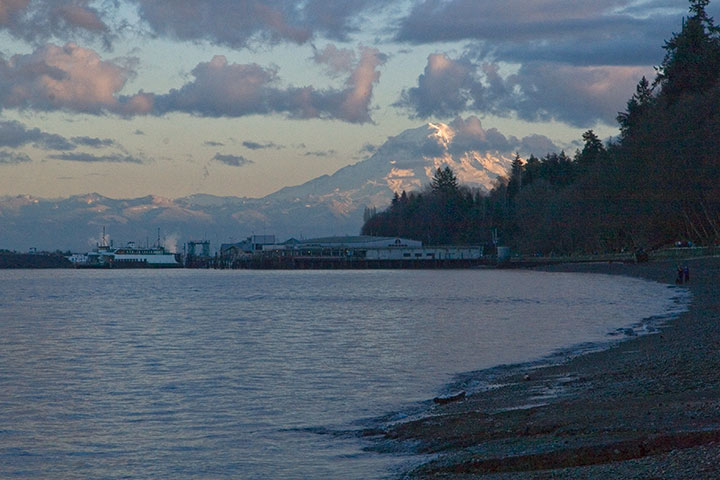
After weeks and weeks of typical winter rain, the Tailor and I took advantage of a rare sunny afternoon and headed to Point Defiance for a stroll on the beach. We quickly discovered that nature had a few surprises for us today—beyond the perpetual shock of Mount Rainier appearing out of nowhere, that is.
The tide was way, way out today; not quite a spring tide, but almost. It was a steep descent down to the water, the crazy slope creating the optical illusion of standing below sea level. At the water’s edge we met a couple of unlucky creatures left high and dry by the tide:
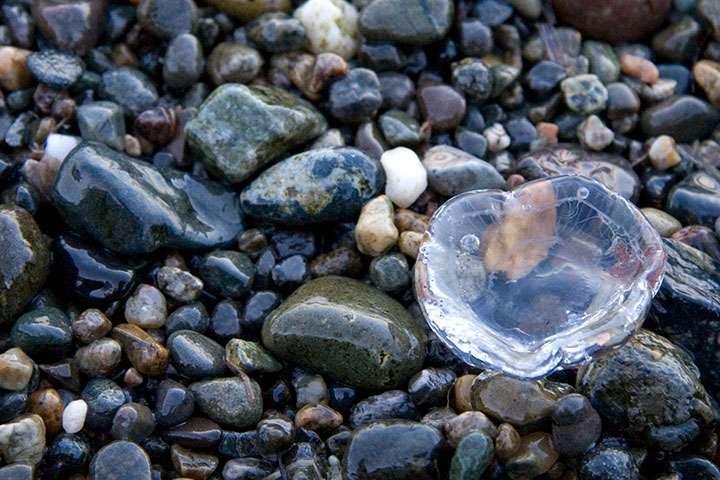
first a half dollar-sized jellyfish that strayed too far into the shallows…

and then a hapless sea star who apparently made a bad choice in real estate (talk about being upside-down on your mortgage).
But the surprise of stranded jelly- and starfish was nothing to the shock we received on our way back, just a few blocks from home:
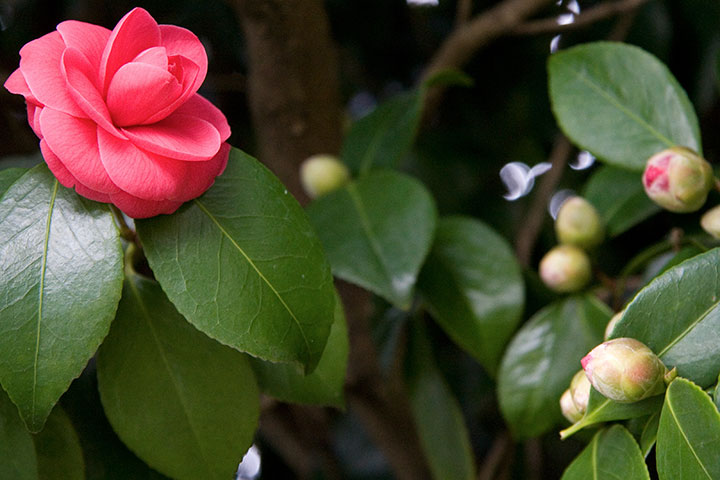
Camellias. Blooming in January. Now, I’m quite confident that I can adapt to the short, snow-less winters in these here parts—but flowers in January? I don’t think I’ll ever be able to wrap my brain around that.
(Not that I’m complaining, mind you.)
January 17th, 2010
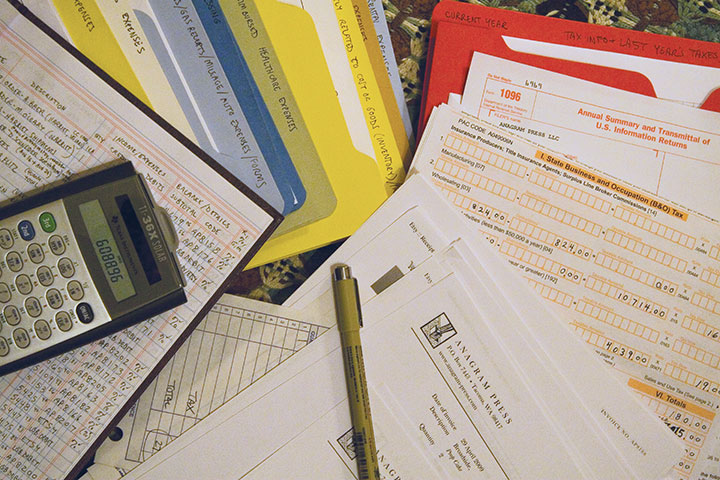
Thing number 386 that they don’t teach you in art school: how to navigate local business excise tax laws.
My wonderful and brilliant accountant takes care of the heavy lifting of my federal business taxes, but since the deadline to pay the Washington piper falls before the federal paperwork even arrives in the mail, I file my state taxes on my own. To be perfectly honest, I take a kind of perverse pleasure in bean-counting—there’s something satisfying about the annual financial housekeeping rituals of compiling and tallying. But now that I own a business in a state that relies solely on sales tax revenue, business excise taxes and weird, archaic, late 19th-century property-assessment laws that tax my homemade bookshelves and vintage filing cabinets (I kid you not), the annual tax ritual has turned into an entire weekend curled up with my calculator.
Since I’m obviously a tax-happy liberal gal who loves her some socialist blueberries (not to mention public libraries and paved roads), I’m perfectly glad to fork over the revenue—I’d just love it if they’d just levy an income tax instead, and spare me (and all those poor state employees) the paperwork nightmare!
Political grumblings aside, I’m just chalking this up to All Those Really Important Things You Have to Learn on Your Own When You Start a Business. I’ve got some fun stuff to share with you, but I’ve gotta get this stuff done first. In the meantime, playing in my head over and over again is that little diddy Bobby McFerrin sang on Square One: “Anything you wanna be, you’ve got to know math.”
So true, Bobby. So true.
December 22nd, 2009
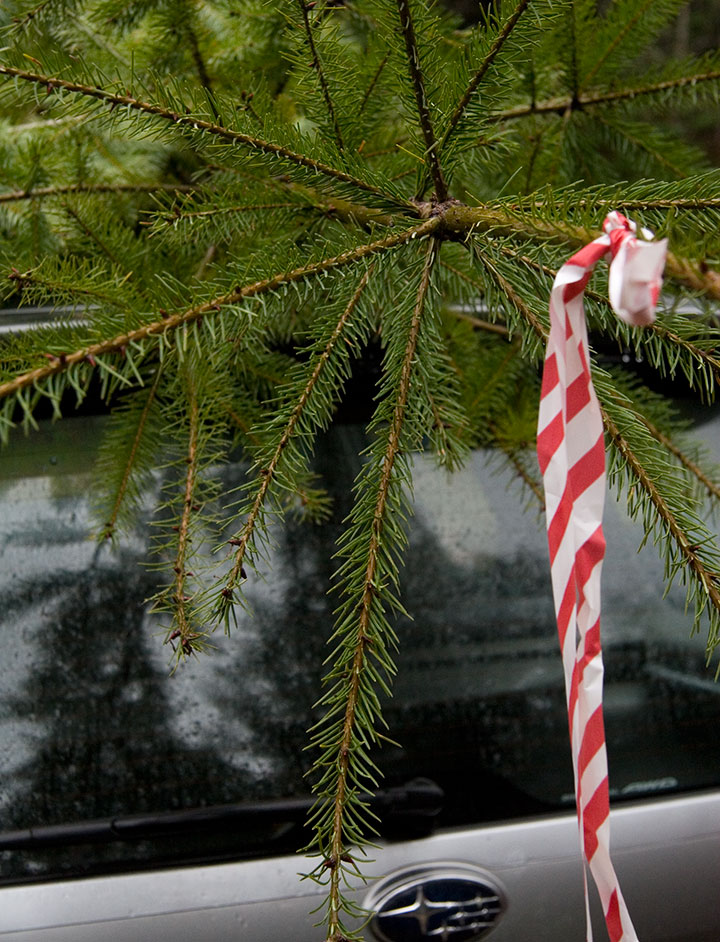
If you’ve been reading this blog for awhile, or you’ve met me or the Tailor, you already know about our penchant for storing food and taking seasonal eating to hardcore extremes. But our nuttiness about walking the talk extends far beyond the pantry. Another aspect of our attempts to live as sustainably as we can is our rejection of synthetic materials. Now, we’ll never live entirely free from petroleum products—we drive a car. We own a refrigerator, a stereo and a plethora of records, tapes, CDs and DVDs. I use a computer, a scanner, a digital camera, and a host of accompanying accessories. I’m not about to buy underwear with a button waist. I gleefully print with photopolymer plates. And we just can’t let go of our small, sentimental collection of deliciously hideous, ancient Tupperware. But all things considered, you’d be hard-pressed to find much plastic in our house. Whenever possible we buy clothing, tools, containers, furniture, and everything else made purely from natural materials: wood, metal, glass, cotton, linen, wool, silk, bamboo, cork, bone, shell. Much of the time, nowadays, that means we have to look for vintage versions of whatever we’re shopping for, but you’d be surprised at what’s available—as long as one is willing to search for it. I know how extreme this position is—and believe me, it’s not something that can be done overnight. This is a process years in the making, and just the fact that we’re still working at it (and probably always will) shows that it’s not for everyone, and certainly not the only solution out there. But the biggest benefit of it all is how long-lasting our belongings are—and when things break, they can usually be mended, rather than thrown away and replaced.
The biggest downside, however, is that by choosing this path we also choose to abstain from some creature comforts and cultural elements that are dated from after the advent of plastic. Most of the time I don’t miss it—or even notice anything lacking. But right now, during the holiday season, I have a fierce craving for twinkle lights that I just have to resist (if anyone can find me twinkle lights made entirely of glass bulbs, metal wire and cloth cord, I’ll be all over it).
Even with our solemn vows to thwart plastic, our search for a Christmas tree left us in some doubt (I grew up with an artificial tree, and have only had one Christmas tree of my own—a real one, three years ago). Is it better to buy a fake tree once or intentionally kill fifty-odd living evergreens in one’s lifetime? Which is worse—fossil fuels or deforestation? How about burning fossil fuels on our way to deforest a section of land?! (The irony of the freshly-killed tree tied to a hippie Subaru in the above photo isn’t lost on me.) And can one family really do so much damage just by celebrating the holidays, or should we just stop worrying so much?
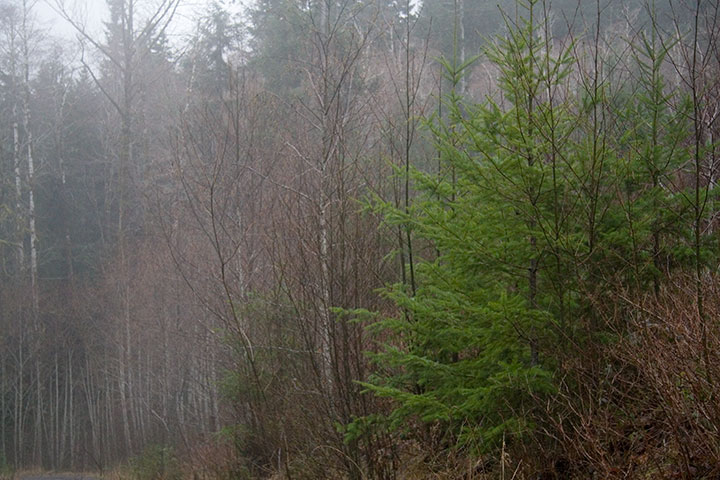
In the end, we followed the same instincts we rely on for our choice to remain omnivores: we decided on a real tree (after all, we do live in a place with abundant trees that shoot up fast, thanks to our rainy climate), as long as it could be culled responsibly. So we called up some friends who own land near Olympia, and as luck would have it, there were some young Douglas-firs on their property that were scheduled to be removed in the spring.
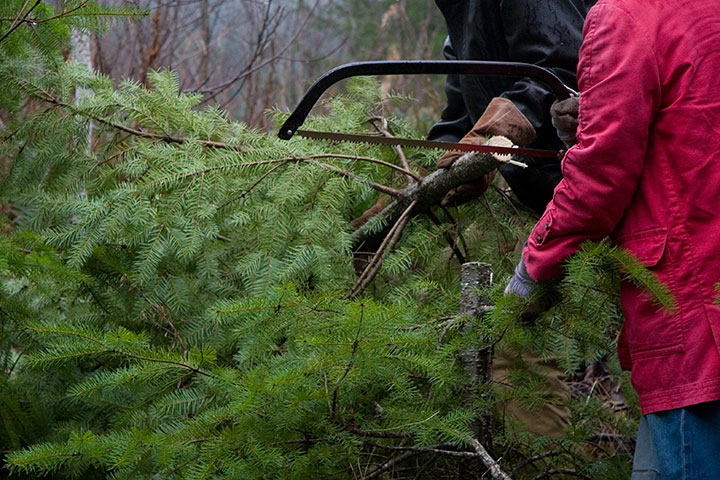
A little elbow grease later, we had our Christmas tree.
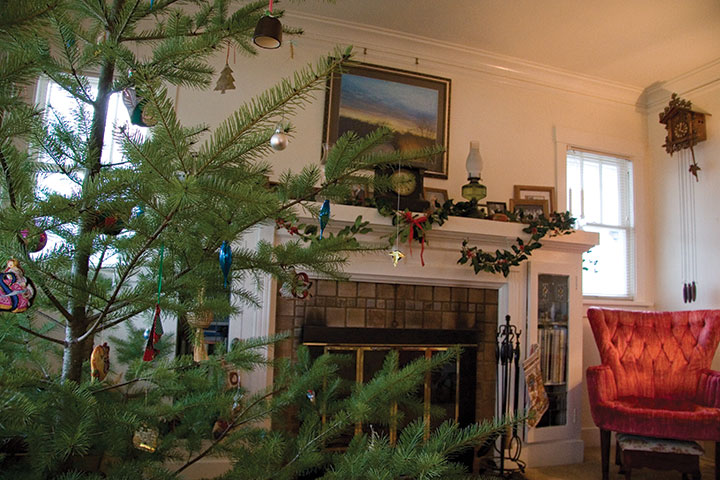
It doesn’t have the textbook perfection of a farmed tree, but it looks lovely in the living room, bedecked in handmade and vintage ornaments (I think there are exactly four plastic items contained therein). And as we decorated it on the solstice, I privately gave thanks to the land for contributing to our holiday.
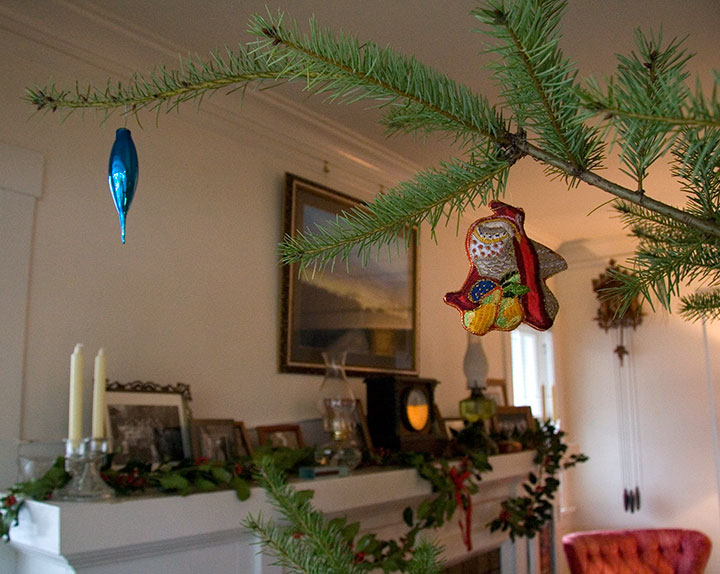
Now that we live in a house with a fireplace, we can finally hang the stockings by the chimney with care. And with a fireplace comes a mantel just begging to be decorated.
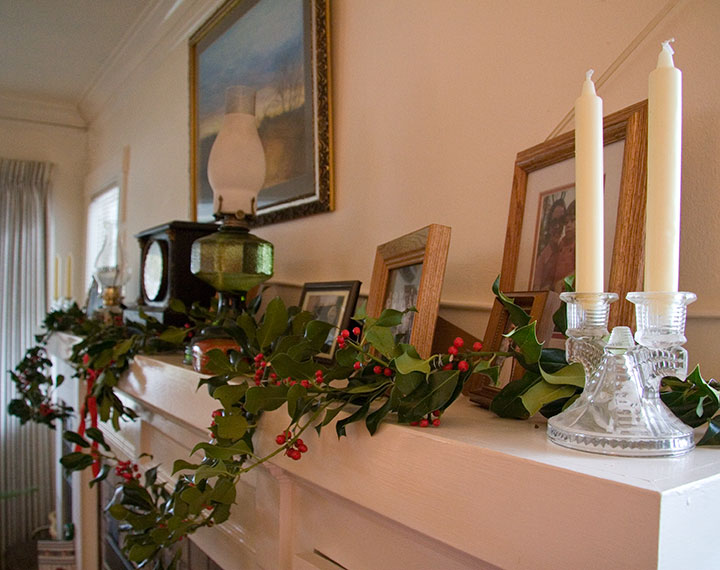
So another friend invited us to clip some holly branches (holly is a beautiful but noxious weed around here, so pruning is always welcome) from his back yard, and with the help of a little steel wire I whipped up a Christmas garland.
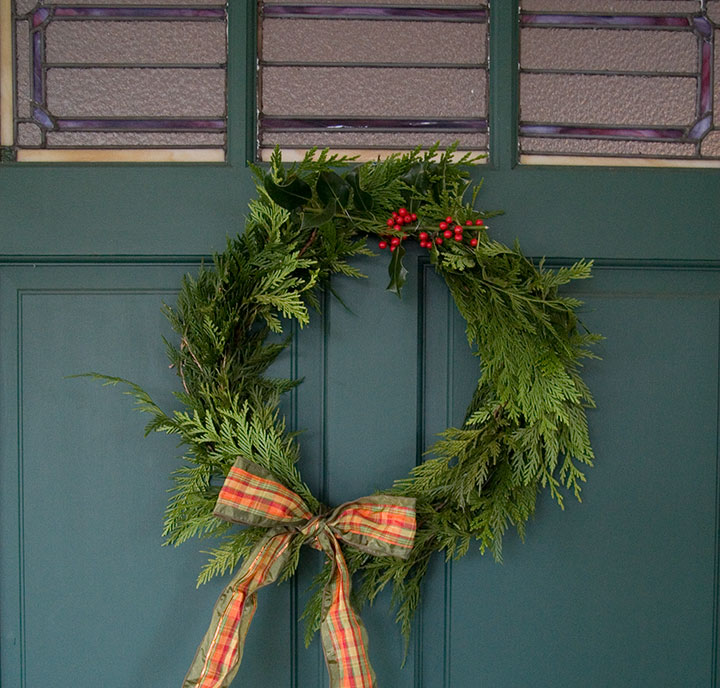
We used a bit of leftover holly and some cedar prunings for a wreath, and suddenly it was Christmas at our house. So maybe I don’t have my beloved twinkle lights, but somehow it feels better this way. We had a big holiday potluck last night, with thirty or so people crammed into our living and dining rooms, bellowing carol harmonies and exploding crackers and cheering when the Tailor poured blue-flaming brandy on the plum pudding. And nearly every one of them said it felt like their grandmother’s house, or their childhood traditions, or what they imagined of Christmases past. So maybe I don’t so much need that string of lights.
Still, since the moment we decided on a real tree I’ve been reminded of my favorite Robert Frost poem—which might make me all the more conscious of our choice, but also more appreciative of the holiday in general. After all, a Christmas tree is something the city “could not do without and keep its Christmas.”
Christmas Trees
(A Christmas Circular Letter)
The city had withdrawn into itself
And left at last the country to the country;
When between whirls of snow not come to lie
And whirls of foliage not yet laid, there drove
A stranger to our yard, who looked the city,
Yet did in country fashion in that there
He sat and waited till he drew us out
A-buttoning coats to ask him who he was.
He proved to be the city come again
To look for something it had left behind
And could not do without and keep its Christmas.
He asked if I would sell my Christmas trees;
My woods—the young fir balsams like a place
Where houses all are churches and have spires.
I hadn’t thought of them as Christmas Trees.
I doubt if I was tempted for a moment
To sell them off their feet to go in cars
And leave the slope behind the house all bare,
Where the sun shines now no warmer than the moon.
I’d hate to have them know it if I was.
Yet more I’d hate to hold my trees except
As others hold theirs or refuse for them,
Beyond the time of profitable growth,
The trial by market everything must come to.
I dallied so much with the thought of selling.
Then whether from mistaken courtesy
And fear of seeming short of speech, or whether
From hope of hearing good of what was mine,
I said, “There aren’t enough to be worth while.”
“I could soon tell how many they would cut,
You let me look them over.”
“You could look.
But don’t expect I’m going to let you have them.”
Pasture they spring in, some in clumps too close
That lop each other of boughs, but not a few
Quite solitary and having equal boughs
All round and round. The latter he nodded “Yes” to,
Or paused to say beneath some lovelier one,
With a buyer’s moderation, “That would do.”
I thought so too, but wasn’t there to say so.
We climbed the pasture on the south, crossed over,
And came down on the north.
He said, “A thousand.”
“A thousand Christmas trees!—at what apiece?”
He felt some need of softening that to me:
“A thousand trees would come to thirty dollars.”
Then I was certain I had never meant
To let him have them. Never show surprise!
But thirty dollars seemed so small beside
The extent of pasture I should strip, three cents
(For that was all they figured out apiece),
Three cents so small beside the dollar friends
I should be writing to within the hour
Would pay in cities for good trees like those,
Regular vestry-trees whole Sunday Schools
Could hang enough on to pick off enough.
A thousand Christmas trees I didn’t know I had!
Worth three cents more to give away than sell,
As may be shown by a simple calculation.
Too bad I couldn’t lay one in a letter.
I can’t help wishing I could send you one,
In wishing you herewith a Merry Christmas.
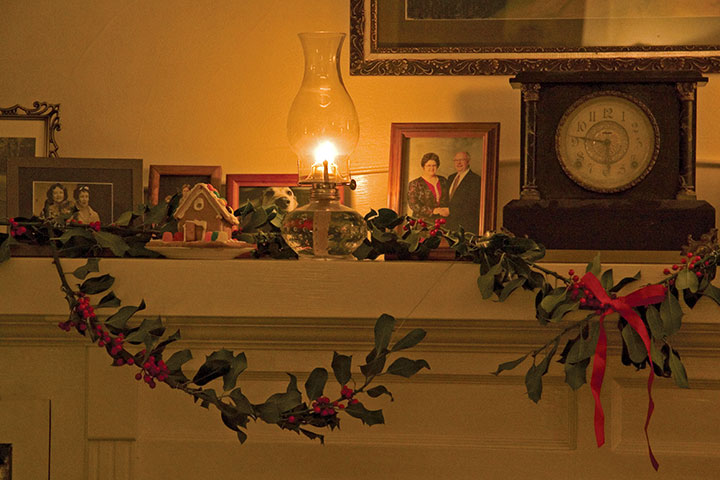
December 6th, 2009
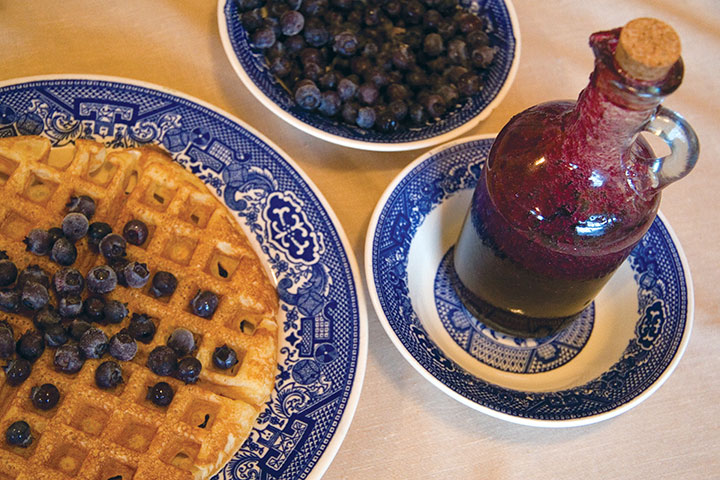
For months now we’ve been finding new ways to use our stores of dried, home-canned and preserved blueberries. But we almost forgot about the containers of fresh berries we threw in the freezer—and on this unseasonably cold* morning, whipping up a little reminder of summer seemed like a good idea.
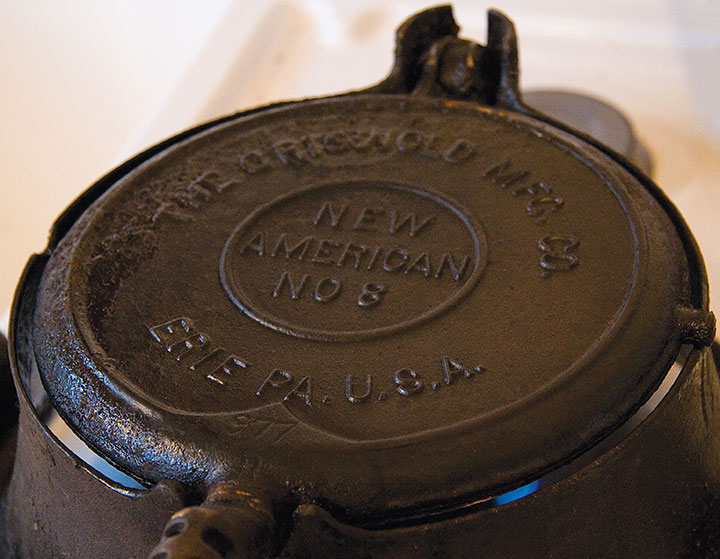
So the Tailor fired up the Cast-Iron Stovetop High-Collared No. 8 Griswold Waffle Iron™ (say that five times fast!), and we had ourselves a good old-fashioned hot breakfast—which, incidentally, goes great with the homemade blueberry syrup above, but the Tailor won’t share that recipe, I’m afraid.
No-Kiddin’ Waffles
2 ¼ cup flour
4 tsp. baking powder
¾ tsp. salt
1 ½ Tbsp. sugar
2 eggs, beaten
2 ¼ cup whole milk
½ cup oil (we use Canola)
Sift the flour, baking powder and salt three times, then add the sugar. In a separate bowl, mix the beaten eggs, milk and oil. Add this to the dry ingredients and mix thoroughly. While some people like to make their batter ahead of time, we’re firm believers in using fresh-fresh-fresh batter. So for best results, make your waffles right then and there.
Oil your cast-iron waffle iron well before starting. Heat both sides of the iron thoroughly (the advantage of a high-collared iron like this is even heating and plenty of room to flip waffles), and remember to apply oil after every third or fourth waffle—a bristle brush is handy for this.

Use a 1/2 cup measure to dip batter—one dip per waffle—and pour the batter into the center of the iron. When you close the lid, the batter will wick evenly into all the nooks and crannies.
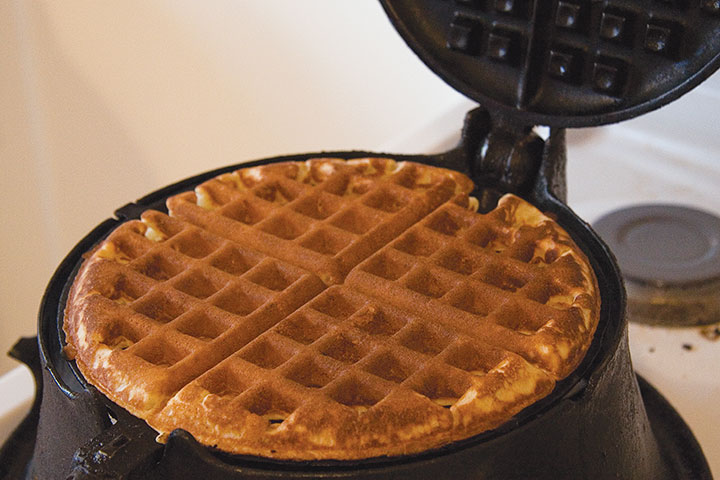
Cook the waffle for 3-4 minutes (peek occasionally to make sure your iron isn’t too hot!), flipping frequently—every thirty seconds or so. The best part (other than the flipping, that is)? Waffles are kind of like pizza—you can jazz them up however you like with your favorite breakfast condiments. But eat ’em fast—a jazzed-up waffle will get cold and soggy** before too long.
That’s never a worry around here, though—these babies get gobbled up long before the next waffle is ready!
• •••••••• ••••••••• ••••••••• ••••••••• ••••••••• ••••••••• •••••••••
* I know all you Minnesotans are rolling your eyes at this declaration, but a nighttime temperature of 17°F is enough to force us to rescue our squash colony from the attic, which isn’t insulated for “real” winter. So until the attic temperature stays above freezing, our pumpkins and butternuts are living in the spare bedroom like edible houseguests—definitely one of the less glamorous aspects of living seasonally.
** I’m really into the specific heat of foods. Mashed potatoes? High specific heat. Fresh waffles? Sadly low.
December 2nd, 2009

Reason number 6,792 why I love it here.
November 20th, 2009
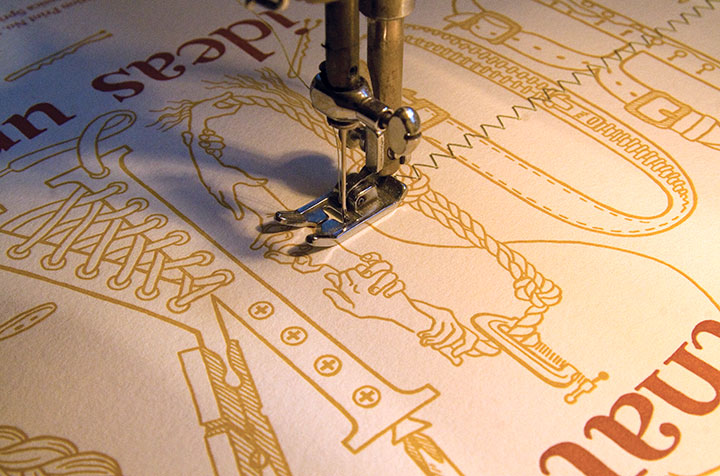
People who stop by the house for the first time must really think I’m strange. Never mind our own personal farmers market residing in the attic and root cellar—these days the place looks like the the visual-art equivalent of Willy Wonka’s Chocolate Factory, with snips of paper, rows of identical bird portraits, bright watercolor cakes, brushes and pencils, boxes of envelopes, shipments waiting to go out, and stacks of prints covering every horizontal surface. It certainly gives new meaning to the term “cottage industry.” I guess that’s what happens when you decide to double your inventory right before the holidays.
This week, though, there was a new element to the chaos: the drone of the sewing machine. And now that all the threads are tied off, Jessica and I are finally ready to unveil a little secret we’ve been sitting on for a few months. Seattle Center for Book Arts (SCBA) asked us to create their second-annual Special Edition Print, and I’m happy to report that they’re now available for sale.

Each year the Special Edition Print has the theme of “Unbound,” and the folks at SCBA challenged us to interpret it how we liked. So instead of our customary work with famous quotes, Jessica whipped up a little gem of her own. We started thinking about all the ways something (not just a book!) might be bound or unbound, which led us to visions of lacing, pinching, tying, zipping, braiding, taping, clamping, buttoning, stitching, buckling, hammering, gluing, clipping, lashing and pinning. Which then, of course, gave me free reign to make an absolute, giddy mess of things, and scatter fasteners and notions all over the page. My favorite additions to the drawing, though, are the bread tags. My grandmother had a whole drawer full of them in her kitchen (did she ever use them, or did I just discover the source of my pack-rat tendencies?), and I loved the way they rattled around in there. So Nana, this one is for you.
Everything is hand-drawn and lettered (as per usual), then letterpress printed in copper ink and an ochre color that is precisely the shade of those little Bit o’Honey candies (remember those?). This time, though, we’ve added a little extra goodie: a line of zig-zag stitching in cotton thread, in exactly the green of copper patina. SCBA is the only place to get these prints, so if you’d like to play a little game of Button, Button, Who’s Got the Button, you can get your copy here.
November 10th, 2009
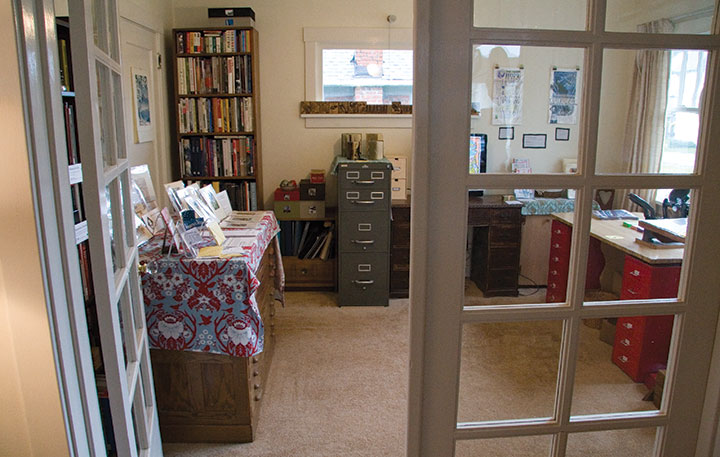
Yowsa! When Tacomans say they’re into art they’re not kidding. Despite absolutely horrendous weather, we had 130 visitors to the studio this weekend! (Hmm…which, oddly enough, is almost exactly the square footage of the space. This is how things looked before that first knock on the door Saturday.)
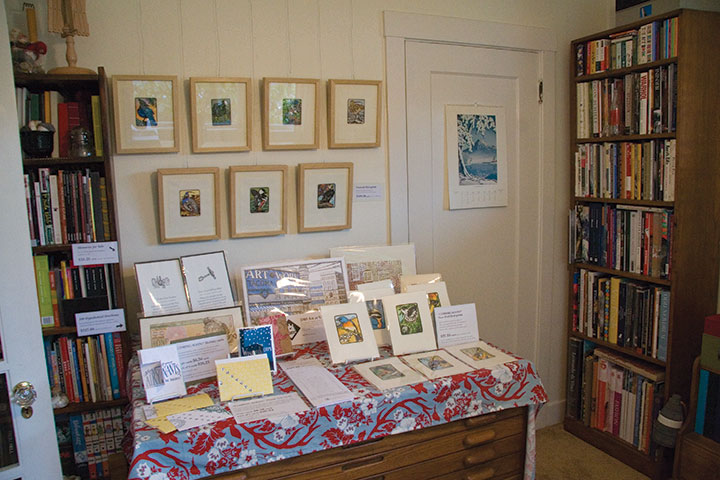
So a vast, colossal thank you is in order for all of you who braved the downpour and jet-propelled ice pellets to get here, and then shoehorned yourselves into the studio to order prints, start a subscription, get your hands dirty on press, or just say hello (sorry the Tailor’s fabulous cookies ran out so quickly). Friends stopped by for a quick hug, gaggles of kids discovered the joys of printing, and one person immediately ran out and bought her own Kelsey press that very same day (you know who you are!), courtesy of Tacoma’s Antique Row. Lots of people returned the second day, and I lost count of all the newcomers and fresh faces. Everybody came with intelligent questions and thoughtful insight, and I’m just overwhelmed by all the kind words of welcome and encouragement. And as if that weren’t gratifying enough, when we finally closed up shop on Sunday, everything was just as tidy as it was on Friday night—no mud tracked in, no prints out of place, no ink straying beyond the demo table. You people are amazing! Sign me up for next year.
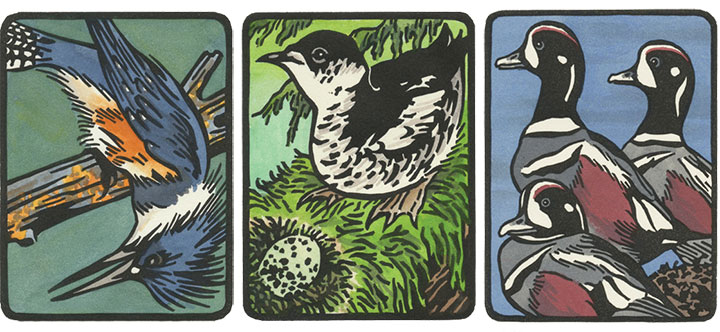
In the meantime there’s still quite a lot of finishing-up to do before the holiday rush consumes my brain (I’m still not over the weird sensation of being on the other end of holiday retail). I’m going to hold onto Marie Curie until Thursday so I can tie up some other loose ends first, so look for it online then.
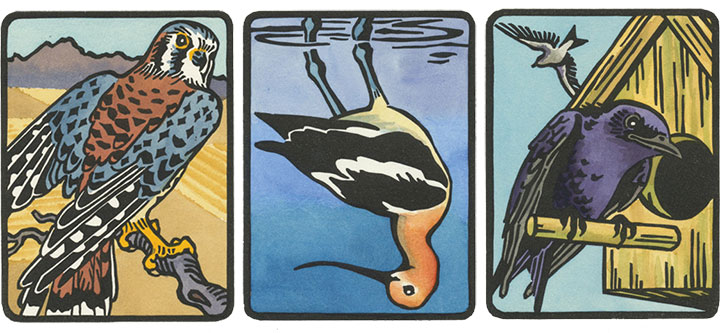
For now, here’s a quick peek of the new birds that were unveiled this weekend. I’m still finishing up the editions (you should see my little watercolor assembly line), so if you placed an order at the studio tour, I’ll be contacting you in the next couple of weeks.
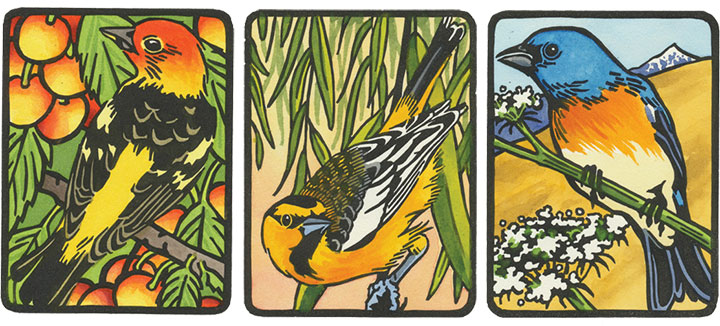
If you’re local but you missed out on the tours this weekend, these little guys will be available at the next Tacoma is for Lovers Craft Fair, held at the inimitable King’s Books on Sunday, November 22, from noon to 5 pm. And for the online world, I’m posting them one-at-a-time, every couple of days in the Etsy shop—just so I don’t get too far ahead of myself!
November 5th, 2009
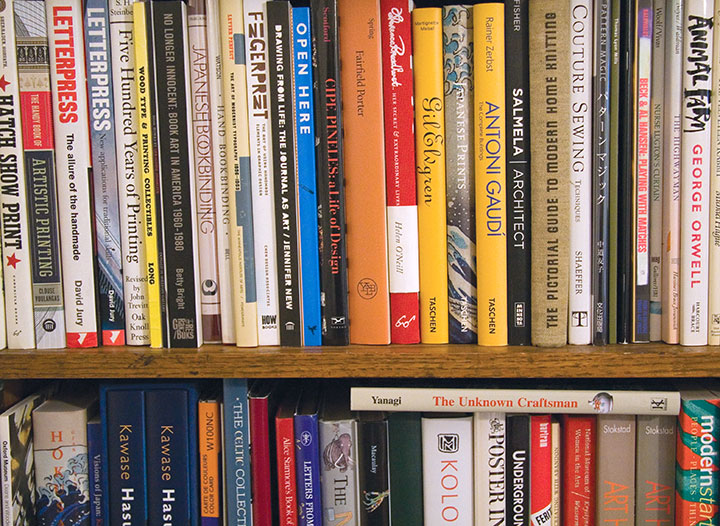
One of the biggest highlights of Tacoma’s annual Art At Work Month is the huge, city-wide Studio Tour circuit, when artists of all stripes (painters, sculptors, printers, photographers, dancers, weavers, jewelers, glassblowers, etc.) open their work spaces to the public and share their processes and products. This year (the eighth year of the event!) there are 39 stops on the tour, and yours truly is joining in on the fun.
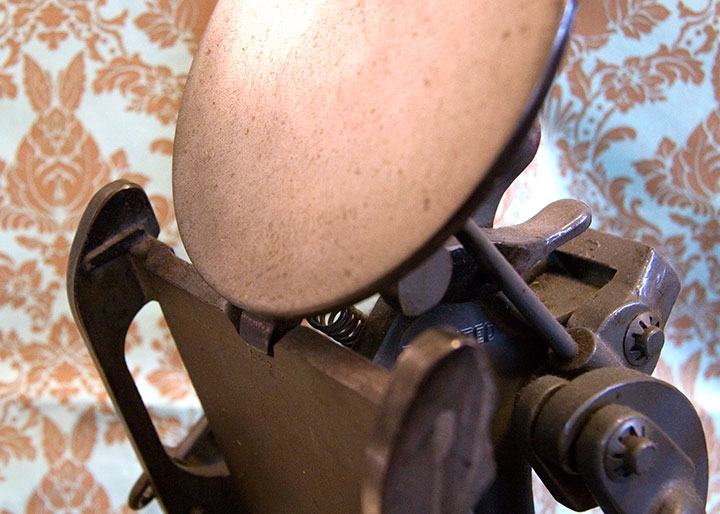
I’ll be firing up the little Kelsey press, so stoppers-by can print their own keepsake and catch the letterpress bug (watch out, it’s contagious!),
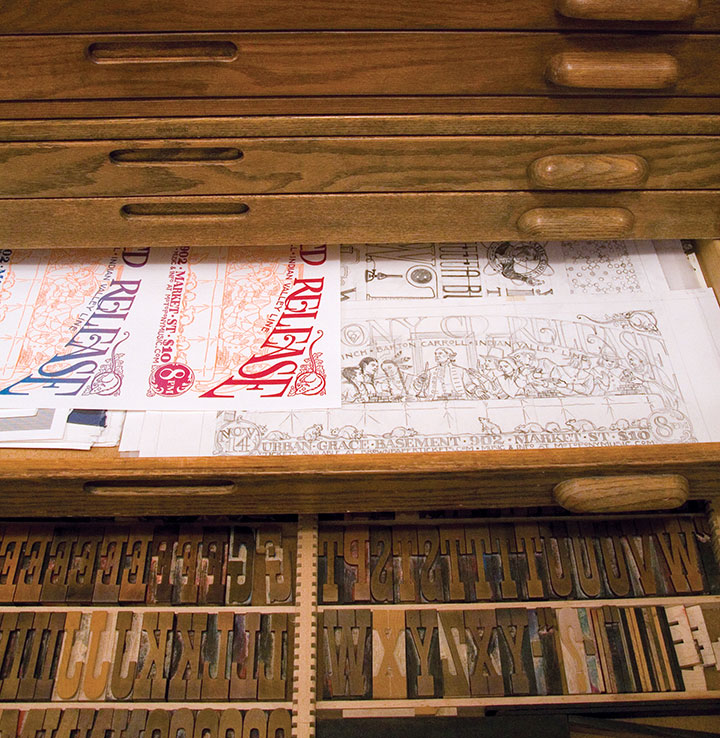
and I’ll have lots of sketches, layouts, tools, and other process materials on display. This is the best part for me, since letterpress and artist books always bring up a lot of questions, and this time I’ll have plenty of visual aids at hand.
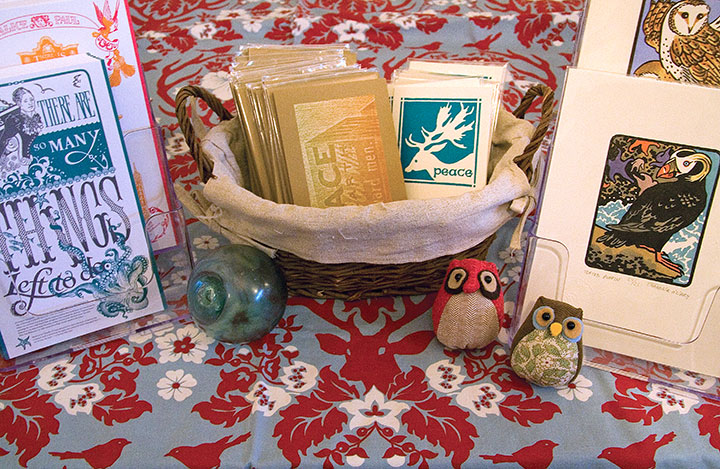
(Stuffed owlets by Mirka Hokkanen, another studio tour artist!)
And since the holidays are just around the corner (or already here, if you believe the Christmas muzak blaring at the grocery store; I proudly promise that Anagram Press will be a carol-free zone), there will be all kinds of goodies for sale, including a boatload of brand-new items. I’ll have copies of the Art At Work poster, a preview of nine (!) new bird prints and several holiday card designs to pre-order, and the unveiling of the newest Dead Feminist broadside. Jessica and I are featuring Marie Curie and the issue of health care this time—but that’s all we’ll share for now. Look for photos and details online next week, but if you want a head start and first pick, you’ll have to come to the tour!
Jessica will be on the tour circuit, too, at her magnificent studio Springtide Press—where she’ll be manning the Vandercook, churning out all kinds of surprises.
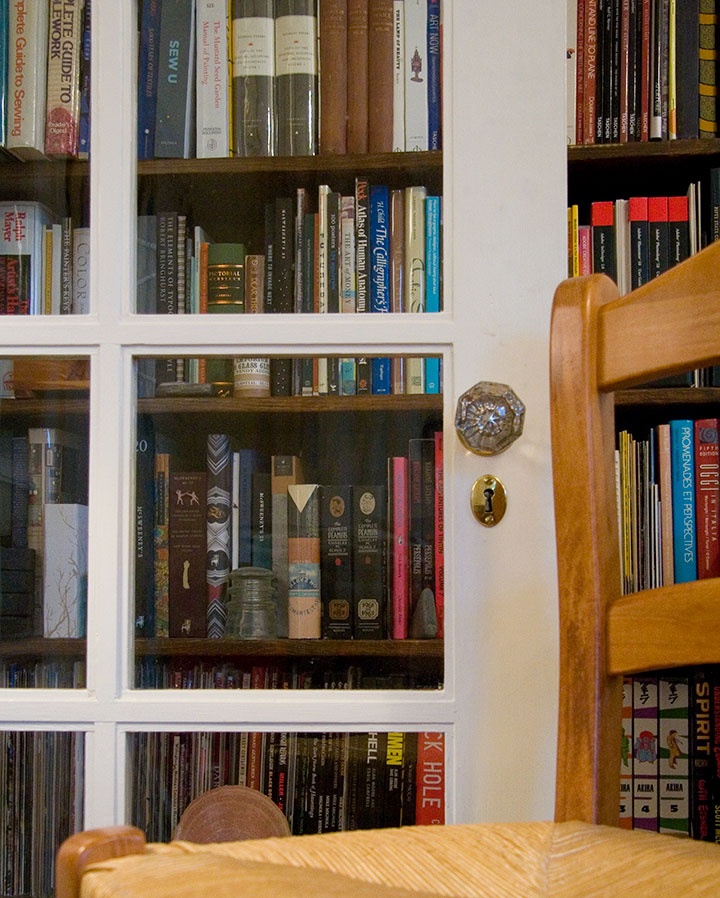
So grab an umbrella, ’cause it’s going to rain (are you surprised?), and take a walk around the neighborhood—Anagram Press and other participating studios will be open from 10 am to 4 pm, this Saturday and Sunday, November 7 and 8. And best of all, the event is free and open to everyone! This is my first time participating in the Studio Tours (Alec Clayton from the Weekly Volcano included me in his list of “must-see studios,” so now I’m officially nervous), so please bear with me while I work out the kinks of hosting a hundred or so guests in my little space—I’ll do my best not to run out of munchies or keepsakes. Come on by and say hello.
November 2nd, 2009
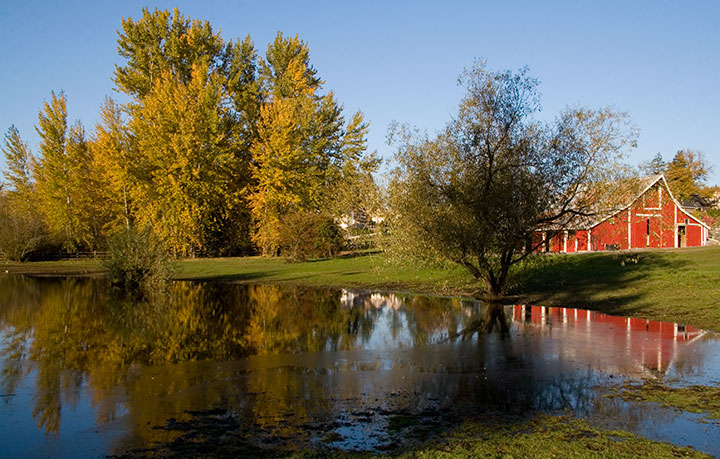
Sunny days are getting fewer and farther between around here, and Mt. Rainier is M.I.A. more often than not. So the gorgeous weather and the threat of an early nightfall (thanks to the end of Daylight Saving Time and living at 47.25° N latitude) were enough to coax me out of the studio and into the car, in hopes of capturing another image for my book.
As far as research goes, the day was a total bust (the Mountain was glorious; I just couldn’t find the right vantage point), but I did come away with an expanded mental map and one good shot.
















![Chandler O'Leary [logo]](https://chandleroleary.com/wp-content/themes/chandleroleary/images/logo.png)






























